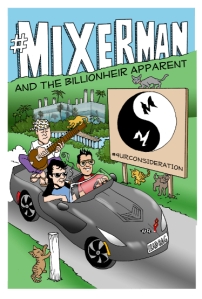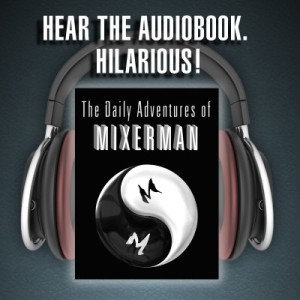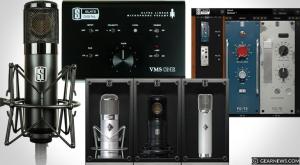This is a brilliant book. Buy it!

#Mixerman and the Billionheir Apparent is one of the best books I have read in years, and THE best one I’ve ever heard, so I suggest buying the audio book. I’ll come back to that. The story is a hilarious satire on the current state of the music industry. Most of us still have the idea that music is the same as in The Beatles’ time, where a group of talented kids from the sticks can make it big by playing endless shows and recording their own songs for a company that provides them whatever they want. In fact, the continuing spate of “new” Beatles products, while in some cases excellent, also prolongs the myth. Even better, bedroom studios are within the budget of any musician, and with the Internet anyone can become rich and famous as long as they have talent, right? The reality is very different. This book presents an industry where those four guys would be working minimum wage jobs and becoming famous, never mind rich, is like winning the lottery. Repeatedly. The book is especially funny for those who have read Mixerman’s first book, The Daily Adventures of Mixerman, and so are familiar with many of the characters who reappear, although this is by no means a requirement. This is the story of an Indian billionaire father whose son wants to be a producer, so naturally dad wants him to be the greatest Bollywood producer of all time. Of course, the son prefers rap and wants to create his first big hit with a ditty about oblivious Prius drivers who slow down traffic, not the most urgent problem in the hood from which famed rappers such as the Pharcyde see the world.
The book revolves around Mixerman getting an offer he can’t refuse to tutor the son and heir (the “billionheir”) of this Indian billionaire in music production. This is the first appearance of money making the seemingly impossible happen, but it won’t be the last. As Mixerman teaches this gifted intern the basics of music, his understanding of the business of music (and ours) is turned upside-down as the very presence of the billionheir changes his world. Along with Mixerman, we learn how money is not a power, but the power, without which success is denied to even the most talented and hardest working musician. Billionaires (and billionheirs) are a club into which not all are welcome, and which can control membership as easily as they control everything else. But our hero Mixerman is a fast learner who has some tricks of his own. Will he and his team ultimately prevail? Read the book and find out. It’s a real page-turner, so you may want to set aside some time for it. Also, if you haven’t yet heard the hit “The Douchebag Song” you might want to wait until it is recorded (or at least written) in the book to get its context. In the audio book, this process is heard, which makes its ludicrous creation, and that of its video, all the more obvious.
Like the best satire, this one does not stray far from reality, and who better to give us an insider’s view of the music business than Mixerman, whose previous four best-selling books have dealt with how grueling the work can be, as well as in-depth technical details for recordists, mixers, and producers. Again like the best satire, there is a darker side to this “American Dream” that begins to surface in short asides from the author, but comes to full fruition in the book’s hysterically funny climax, where the line between the truly absurd and the actual modern world is shown to be an illusion. And in one of the most inspired moments in modern writing, the lens on the oligarchic control of music suddenly pulls back to reveal this undemocratic control of virtually every important aspect of life.
So there is a serious and sad sub-text to this book, but it is embedded in a truly great story. It shows that Mixerman is as brilliantly creative at a word processing keyboard as he is at his beloved Slate Raven MTX recording console. Don’t worry, this is the same uncensored, fattie-loving, musically amazing Mixerman we have learned so much from, but his writing has a new depth and flow to it now that he is free from having to present so many technical facts. In his own inimitable style, Mixerman presents the most important issues of our time that affect every one of us. I found the audio presentation even more immediate, with great performances by a huge cast that really puts you into the middle of the action, and things get quite active.
This is a book that will appeal to two groups: musicians, and everyone else. Musicians will see that they really are up against a system virtually designed to deny them success, while non-musicians will see the way that the systemic inequalities that they find virtually everywhere in life are at their worst in the creative arts. Let’s look at one change in technology that has been in the news lately: streaming. Many of us don’t realize much difference between streaming songs and songs sold on CD. Streaming is touted as being more convenient and cheaper. Why buy a physical object that you have to store yourself and find when you want to hear music when you can just stream it on demand to whichever of your devices is closest to hand? The problem is that far fewer people are paid from streams, and they are paid far less (if at all). Many producers, songwriters, and artists count on their royalties to carry them through retirement, but with those royalties gone with the disappearance of CD sales, so is any thought of retiring. The even more devious catch is that with so many new artists, songwriters, and producers trying to get into the business, the resulting price war means that many will work for free just for the experience and exposure. How does one compete with free? (I’ve faced this myself with guitarists who pay bar owners for the chance to play in public!)
We are all familiar with the huge disparity between the 1% of the ultra-wealthy and the 99% of “everybody else.” In music, this is even worse. If this sounds like a bummer to read, many of us are living it. And kudos to Mixerman for blowing the whistle while still keeping the tone hilarious even as he teaches us the harsh truths of modern music. He achieves this through his deft touch, his wonderfully ingratiating characters, and his ability to make his point effectively and move on with the story. The audio book adds music to the story, using leitmotifs (identifying tunes) for each character that describe them as well as pointing up their similarities and differences. Music also provides moments to reflect on how this situation affect us personally.
The situation is ultimately bad for music, and for most of us in general, but unlike doomsayers Mixerman does point to a way out, if only enough of us demand it. The first step is to discover what is going on, and this book makes it clear, but with enough humour to keep you laughing, which ultimately helps you to remember his points. Then you can discuss this with your friends and colleagues. No one of us has an answer to this dire situation, but unless we work together none of us ever will. This is how we are controlled: distract and separate. And it works — if you let it. For example, if you feel that you are the only one not getting rich despite your state-of-the-art home studio, you are going to keep your “failure” to yourself. However, if you discover that every one of your colleagues is in the same situation and feels the same way, you have the start of a discussion. And it’s OK if it’s an angry one.
For those of you ready to fire up a torrent client I’d suggest actually buying the book because you are going to feel pretty guilty while reading or listening to it. With streaming services paying the bulk of their “royalties” to large corporations (tech or music), the songwriters and artists (including writers) make little enough as it is. Ripping them off by pirating their work only adds injury to injustice. It also takes away the incentive to create new works when you would make more money at a minimum-wage job. And we all owe a debt of thanks to Mixerman — one of the most pirated authors around (8 pirated per one sold) — for bothering to write what is a very important book that is also hilariously funny.
A note on the audio book: It is supposed to be available on audible.com (“an Amazon company”) but after more than two weeks they still have been unable to get my legally purchased copy to work on my Macintosh computer (where it can only be played in iTunes). In fact, they have ceased to communicate with me at all. Some “customer service.” Mixerman himself tells me that the iTunes store is a more reliable place to purchase it.
I’m glad to have both print and audio versions of this book. I like to read in bed, and after a hard day, reading a very funny book about music is the perfect way to wind down. In the car or just some down time, the audio book is a perfect companion. The production of the audio is as good as you would expect from a master producer, and the theme music for the characters is just as great as the hit single itself. The voice actors are excellent and Mixerman does himself proud to keep up with so talented a group.
So get a legal copy of the book, audio, or both and join in the fun. Then join in the discussion on how all people in the music industry, and your own, should make a fair wage. Include your elected representatives in your discussions too. You may have to remind them that they represent you too, and even a billionaire has the same one vote that you do. Money has a powerful voice, but a majority of the electorate has a more powerful one. Join the conversation.










